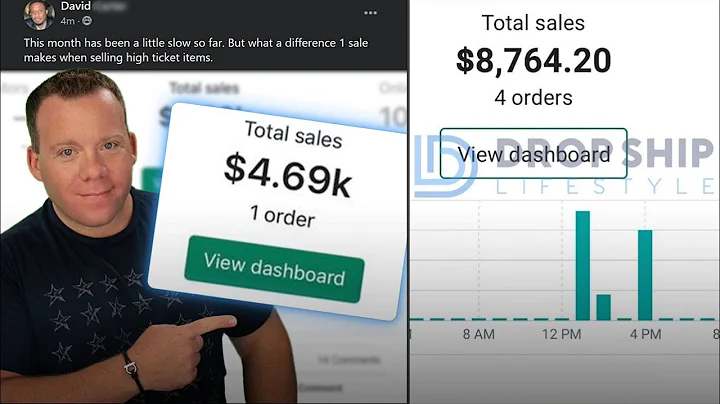Ultimate Guide to Successful Amazon Dropshipping
Table of Contents:
- Introduction to dropshipping on Amazon
- Recent Changes to Amazon's Dropshipping Policy
- Understanding Amazon's Dropshipping Policies
3.1 Identification as the Seller on Invoices and Packaging
3.2 Accepting and Processing Returns
3.3 Compliance with Amazon's Terms of Service
- How Dropshipping on Amazon Works
4.1 The Process of Dropshipping on Amazon
4.2 Finding Suppliers with No Branding on Packaging
- Finding Profitable Products for Dropshipping on Amazon
5.1 Using Amazon's Best Sellers for Product Research
5.2 Using Jungle Scout's Sales Estimator Tool
5.3 Using Jungle Scout's Opportunity Finder
- Selecting Suppliers and Monitoring Shipping Times
6.1 Using AliExpress for Dropshipping
6.2 Using C.J. Dropshipping for Dropshipping
6.3 Evaluating Processing and Shipping Times
- Determining Product Price and Profitability
7.1 Analyzing Average Monthly Prices on Amazon
7.2 Calculating Profit Margins using Jungle Scout
- Contacting Suppliers and Ordering Sample Units
8.1 Communicating with Suppliers on AliExpress
8.2 Contacting Suppliers on C.J. Dropshipping
8.3 Importance of Ordering Samples
- Setting Up a Seller Central Account and Creating Listings
9.1 FBA vs FBM Listings on Amazon
9.2 Step-by-Step Guide to Creating an FBM Listing
Dropshipping on Amazon: A Comprehensive Guide for Success
Dropshipping has become a popular business model in recent years, allowing entrepreneurs to start an online store without having to hold inventory. One of the platforms where dropshipping has gained significant traction is Amazon. However, it's essential to note that dropshipping on Amazon has evolved, and understanding the recent changes and policies is crucial to maintain a successful business.
Recent Changes to Amazon's Dropshipping Policy
Amazon has implemented specific policy updates regarding dropshipping to ensure a positive experience for customers and sellers alike. These changes aim to prevent issues such as delayed shipments, subpar product quality, and unauthorized selling. It's vital for aspiring dropshippers to familiarize themselves with these changes to avoid potential account suspensions.
Understanding Amazon's Dropshipping Policies
To dropship successfully on Amazon, it's essential to adhere to three key policies set by the platform. Firstly, sellers must ensure that all invoices and packaging do not include any information about the supplier or manufacturer. This means that the branding and design on the packaging should solely reflect the seller. Secondly, sellers must take responsibility for accepting and processing returns, which involves setting their address as the default return address on their seller account settings. Lastly, sellers must comply with all of Amazon's terms of service, adhering to the same rules that apply to other sellers on the platform.
How Dropshipping on Amazon Works
Dropshipping on Amazon follows a straightforward process. A customer purchases a product listed on Amazon, and the seller receives the funds from the transaction. The seller would then source the product directly from the supplier and provide them with the customer's shipping information. It is crucial to find suppliers that do not include any branding or identifiers on their packaging, ensuring that the product appears to be shipped directly from the seller.
Finding Profitable Products for Dropshipping on Amazon
Finding the right products to dropship on Amazon is crucial for success. Utilizing tools like Amazon's Best Sellers page can help identify products that are already in high demand. Additionally, using Jungle Scout's Sales Estimator Tool and Opportunity Finder can provide insights into product sales, competition, and profitability. By combining these resources, dropshippers can discover profitable niches and select the most promising products to list on Amazon.
Selecting Suppliers and Monitoring Shipping Times
When dropshipping on Amazon, it's essential to choose reputable suppliers that can deliver products efficiently. AliExpress and C.J. Dropshipping are two popular platforms that cater to dropshippers. It's crucial to evaluate the processing and shipping times offered by suppliers, ensuring that customers receive their orders within a reasonable timeframe. By selecting suppliers that offer quicker shipping options, such as shipping from the United States, dropshippers can enhance the customer experience.
Determining Product Price and Profitability
Calculating the right product price is essential for dropshippers to maximize profitability. Analyzing the average monthly prices of similar products listed on Amazon can provide insights into market trends and set a competitive price point. Tools like Jungle Scout's Profit Calculator can help determine profit margins by factoring in the product cost, fees, and shipping charges. By offering products with attractive price points and high profit margins, dropshippers can boost their chances of success.
Contacting Suppliers and Ordering Sample Units
Before listing products on Amazon, it's crucial to communicate with suppliers to ensure they can meet specific requirements, such as hiding branding information on packages. Platforms like AliExpress and C.J. Dropshipping provide options for contacting suppliers directly to discuss these details. To ensure product quality and accurate shipping, ordering sample units is highly recommended. This allows dropshippers to assess the product's quality, functionality, and delivery time, ensuring a positive experience for customers.
Setting Up a Seller Central Account and Creating Listings
To start dropshipping on Amazon, sellers must set up a Seller Central account. It's important to understand the difference between Fulfillment by Amazon (FBA) and Fulfilled by Merchant (FBM) listings. For dropshipping, FBM listings are the preferred choice, as sellers are responsible for shipping the products themselves or through their suppliers. Creating FBM listings involves following a step-by-step process, which can be learned through a comprehensive guide provided by Jungle Scout.
In conclusion, dropshipping on Amazon presents a promising entrepreneurial opportunity. By understanding Amazon's dropshipping policies, finding profitable products, selecting reliable suppliers, and creating effective listings, dropshippers can achieve success in this competitive marketplace. With careful planning, attention to detail, and consistent execution, dropshipping on Amazon can be a lucrative business venture.



















